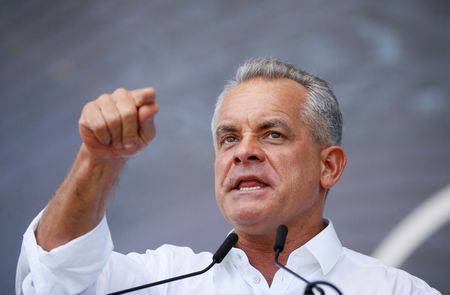By Gergely Szakacs
BUDAPEST (Reuters) -Central Europe has limited fiscal space to offset the economic hit from tariffs given high deficit levels across much of the export-reliant region, which must find new engines for growth amid a shake-up of the world economy, Moody’s Analytics said.
Despite low direct exports to the U.S., central Europe is among the European Union’s most trade-reliant regions, with goods exports as a share of output ranging from 75.5% in Slovakia to 39.4% in Poland — all above a 34.2% EU average.
Tariffs have darkened the outlook for Europe as a whole, raising recession risks and slashing growth prospects in the Czech Republic, Romania and Hungary, Gaurav Ganguly, head of EMEA Economic Research at Moody’s Analytics told Reuters.
The analytics arm is a separate unit to the one that sets credit ratings.
“The U.S. is retreating into isolationism. That’s putting a huge pressure on the global economy, and particularly on countries that are exposed to the global trading system and that have relied on trade as an engine for growth,” he said.
“It is very important for these countries to find new export markets, to find new partners, to find new engines for growth.”
Ganguly said these could include export promotion, new trade and investment alliances, promoting new industries or attracting foreign investment from other countries.
“The policy environment and the tariff environment is such that it’s creating some very big structural problems for growth,” he said. “If countries don’t address that, they will have some medium-term issues, not just short-term issues.”
The war in Ukraine, increased defence spending and elections have contributed to higher borrowing in central Europe, with Poland and Romania, the region’s largest economies, racking up the 27-member EU’s highest budget deficits last year.
“There seems to be a lot of spending rigidity in Poland, so that’s putting huge pressure on fiscal consolidation efforts on the expenditure side,” Ganguly said, adding that Poland needs to work harder to ensure its lower deficit targets stay credible.
While debt levels in both Poland and Romania are still below the EU average, Poland’s debt servicing costs as a percentage of output have doubled since 2021, while Romania’s interest bill increased by one percentage point to 2.3% of output.
Ganguly said he was “much more concerned” about Romania, where the deficit rose to 9.3% of output last year, exceeding even its COVID-19 pandemic highs. First-quarter figures last week showed the gap widening further on an annual basis.
“Unless the government acts very urgently to increase fiscal consolidation, then particularly given this much darker growth outlook, we are going to see a worsening in the budget deficit for 2025 and 2026,” Ganguly said, projecting the shortfall at 8.4% of output this year and 7.1% in 2026.
While Hungary managed to trim its deficit last year despite running the EU’s highest interest bill, the government is pushing ahead with large-scale income tax cuts ahead of a 2026 election, even amid risks to growth and high inflation.
(Writing by Gergely SzakacsAdditional reporting by Luiza IlieEditing by Sharon Singleton)











